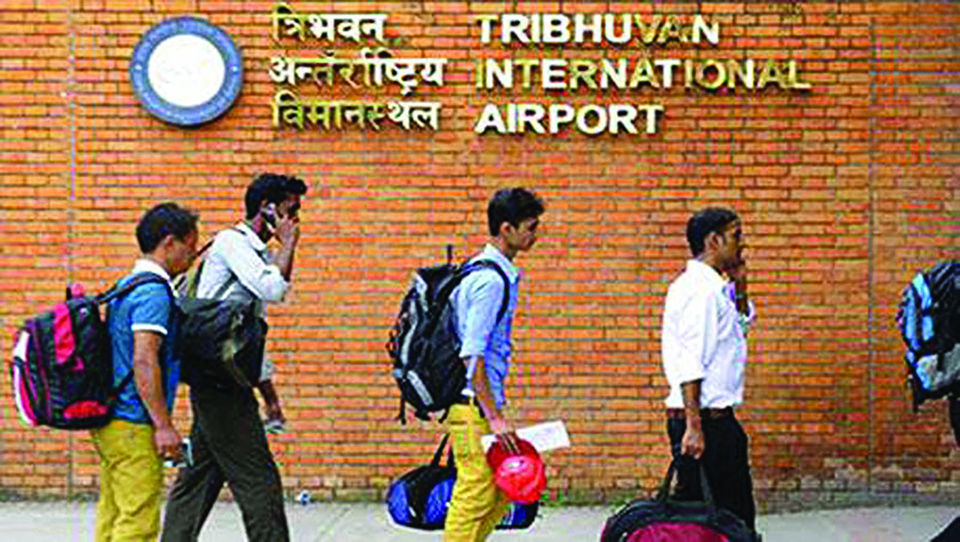
OR

More from Author
Let’s use returning migrants’ skills and earnings to increase domestic production
Our trade deficit is ballooning. And if this trend continues our economy will be in deep waters. Our nation’s balance of payment, foreign currency reserves, surplus and domestic capacity of production, and other indicators aren’t very encouraging.
The trade deficit has hit Rs 1,321 billions, the highest level ever, in the current fiscal year. Compared to FY 2017/18, export-import ratio stands at 1:15. This is a situation where we are importing goods worth 15 rupees and exporting goods worth one rupee! Import captures almost 93.6 percent in our total trade. According to a report by the Asian Development Bank (ADB), by mid-February 2019, trade deficit worsened the current account deficit to US$ 1.5 billion. The current account deficit is likely to worsen in the months to come.
In FY 2018/19 the dollar reserves was enough to import goods for 7.7 months, down from 9.6 months in the FY 2017/18. Likewise, for the first time in history, trade deficit at the end of 2018/19 superseded the total yearly budget. This is only the story of trade in goods. The story of trade in services is even scary—vastly understated.
One must acknowledge that domestic production cannot currently meet our domestic demand of goods and services. And domestic production is negligible to bolster our exports. Both agriculture and industry sectors failed to properly utilize remittances. Remittances brought in $8.2 billion in FY 2018, 28 percent of our GDP. Health of our foreign currency reserves relies on Nepali migrant workers working all over world. More than 4.3 million young workers are working under difficult conditions around the world and number is likely to jump if we include the ones working in India.
Huge inflow of remittances propelled massive growth in consumption. And this consumerism triggered demand in market. As a result, savings shrunk to 15 percent in FY 2017/18 and the remaining 85 percent was used for importing foods, vehicles, petroleum products, garments, pharmaceuticals and luxury goods.
Lost opportunity
We lost our battle to increase domestic production. Surge in demand is always an opportunity but that turned out to be a risk for us. The Keynesian theory of demand-led growth underscores that an increase in aggregate demand increases total output in the long run.
The World Bank’s Migration and Development Brief-31, 2019 says India was the top remittances recipient ($79 billion), followed by China ($67 billion), Mexico ($36 billion), the Philippines ($34 billion), and Egypt ($29 billion). But none of the countries have trade deficit like Nepal. The policies associated with investments, industry, labor, agriculture, trade, land management, monetary and fiscal instruments, revenue rightly marshaled the economy.
Nepal does not have the luxury to fail. We are no longer a country in transition. Hence, aggressive policy departure is the only solution at this time. An orchestra of all relevant policies is urgently needed. All three tiers of governments must work together.
A plan to increase both agriculture and non-agriculture products has been introduced. And this should be implemented, along with other policy reforms to increase investments in domestic production. Remittances bring in not just money, but also knowledge, skills and entrepreneurship. By utilizing their expertise, the demand raised in the market could be better served with Nepali products. South Korean Ambassador Park Young-Sik shared a story of Korea: During the 60s and 70s, Korean workers came back from Germany with good savings and knowledge and the country utilized such resources to boost the Korean production. It is now time for Nepal to do exactly the same.
The author is a secretary, Government of Nepal
chandraghimire8@gmail.com
You May Like This

Remittance Economy: Appealing or Appalling?
People’s increased purchasing capacity won’t matter if we can’t hold the money home. Capital flight adds to the problems and... Read More...

Failing to impress
The well-known economist was expected to take drastic measures to rejuvenate the country’s economy but this has not happened under... Read More...

Economy of emotions
Let’s bring in remittance as much as we can through skills but not at the cost of our emotional wellbeing Read More...





Just In
- NRB introduces cautiously flexible measures to address ongoing slowdown in various economic sectors
- Forced Covid-19 cremations: is it too late for redemption?
- NRB to provide collateral-free loans to foreign employment seekers
- NEB to publish Grade 12 results next week
- Body handover begins; Relatives remain dissatisfied with insurance, compensation amount
- NC defers its plan to join Koshi govt
- NRB to review microfinance loan interest rate
- 134 dead in floods and landslides since onset of monsoon this year













Leave A Comment